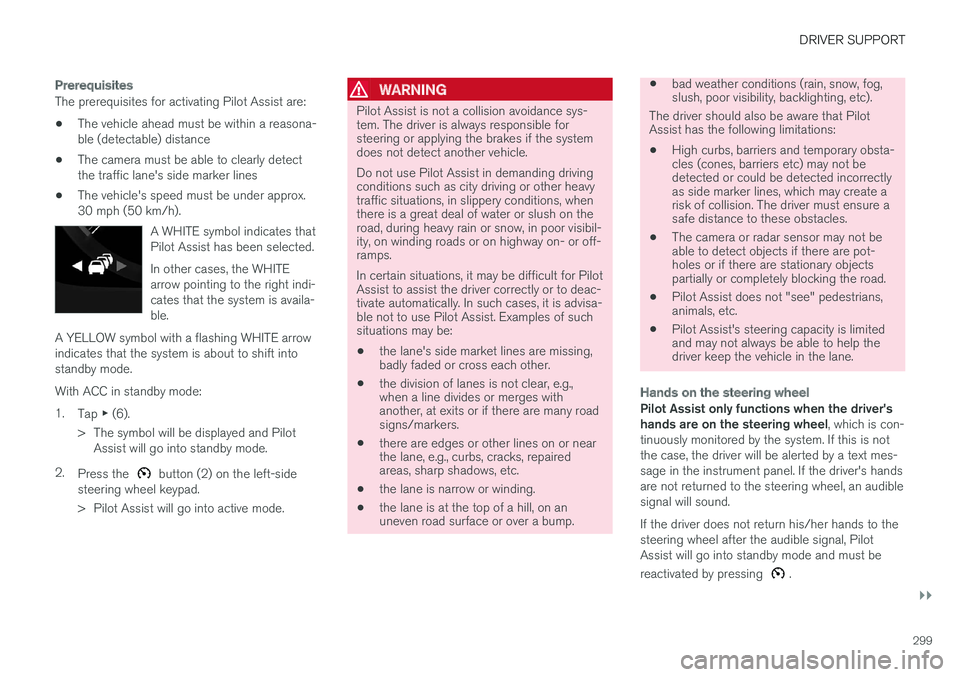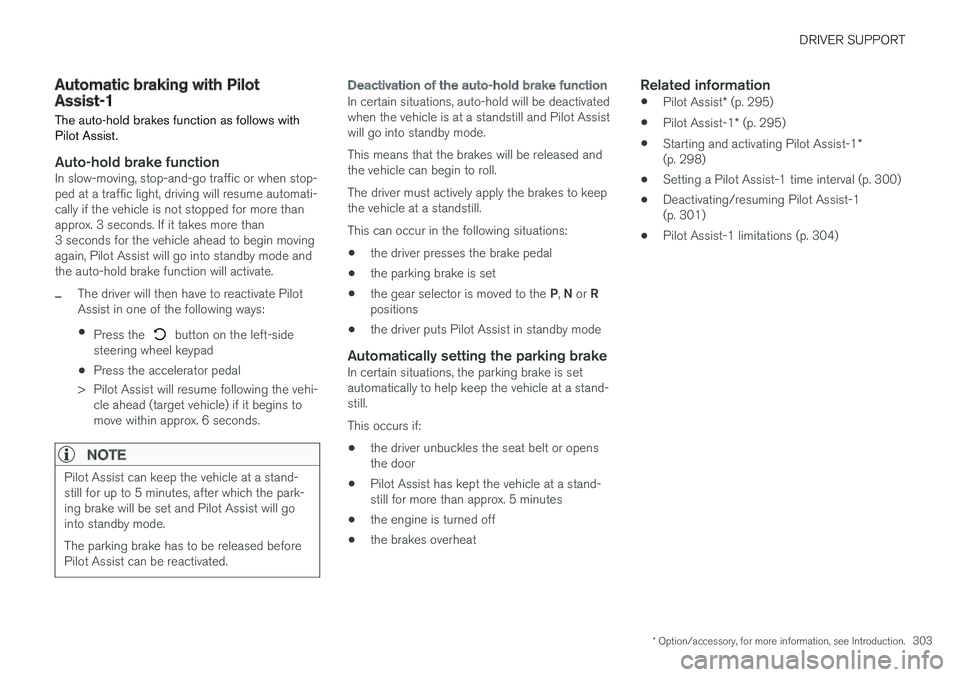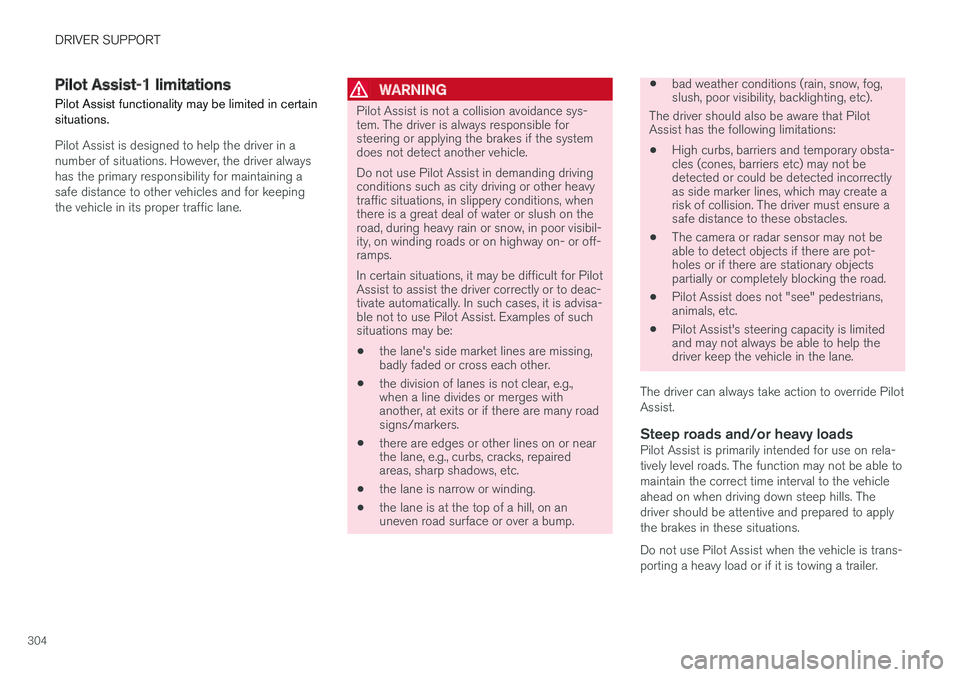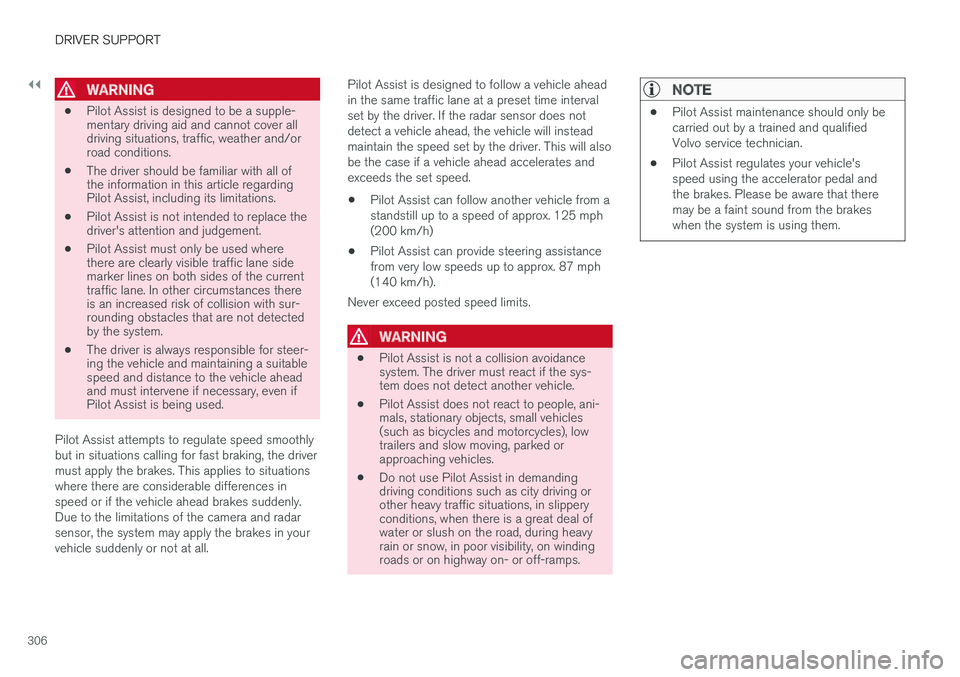VOLVO XC90 TWIN ENGINE HYBRID 2017 Owners Manual
Manufacturer: VOLVO, Model Year: 2017, Model line: XC90 TWIN ENGINE HYBRID, Model: VOLVO XC90 TWIN ENGINE HYBRID 2017Pages: 584, PDF Size: 14.2 MB
Page 301 of 584

DRIVER SUPPORT
}}
299
Prerequisites
The prerequisites for activating Pilot Assist are:
•The vehicle ahead must be within a reasona-ble (detectable) distance
•The camera must be able to clearly detectthe traffic lane's side marker lines
•The vehicle's speed must be under approx.30 mph (50 km/h).
A WHITE symbol indicates thatPilot Assist has been selected.
In other cases, the WHITEarrow pointing to the right indi-cates that the system is availa-ble.
A YELLOW symbol with a flashing WHITE arrowindicates that the system is about to shift intostandby mode.
With ACC in standby mode:
1.Tap ▶ (6).
>The symbol will be displayed and PilotAssist will go into standby mode.
2.Press the button (2) on the left-sidesteering wheel keypad.
>Pilot Assist will go into active mode.
WARNING
Pilot Assist is not a collision avoidance sys-tem. The driver is always responsible forsteering or applying the brakes if the systemdoes not detect another vehicle.
Do not use Pilot Assist in demanding drivingconditions such as city driving or other heavytraffic situations, in slippery conditions, whenthere is a great deal of water or slush on theroad, during heavy rain or snow, in poor visibil-ity, on winding roads or on highway on- or off-ramps.
In certain situations, it may be difficult for PilotAssist to assist the driver correctly or to deac-tivate automatically. In such cases, it is advisa-ble not to use Pilot Assist. Examples of suchsituations may be:
•the lane's side market lines are missing,badly faded or cross each other.
•the division of lanes is not clear, e.g.,when a line divides or merges withanother, at exits or if there are many roadsigns/markers.
•there are edges or other lines on or nearthe lane, e.g., curbs, cracks, repairedareas, sharp shadows, etc.
•the lane is narrow or winding.
•the lane is at the top of a hill, on anuneven road surface or over a bump.
•bad weather conditions (rain, snow, fog,slush, poor visibility, backlighting, etc).
The driver should also be aware that PilotAssist has the following limitations:
•High curbs, barriers and temporary obsta-cles (cones, barriers etc) may not bedetected or could be detected incorrectlyas side marker lines, which may create arisk of collision. The driver must ensure asafe distance to these obstacles.
•The camera or radar sensor may not beable to detect objects if there are pot-holes or if there are stationary objectspartially or completely blocking the road.
•Pilot Assist does not "see" pedestrians,animals, etc.
•Pilot Assist's steering capacity is limitedand may not always be able to help thedriver keep the vehicle in the lane.
Hands on the steering wheel
Pilot Assist only functions when the driver'shands are on the steering wheel, which is con-tinuously monitored by the system. If this is notthe case, the driver will be alerted by a text mes-sage in the instrument panel. If the driver's handsare not returned to the steering wheel, an audiblesignal will sound.
If the driver does not return his/her hands to thesteering wheel after the audible signal, PilotAssist will go into standby mode and must be
reactivated by pressing .
Page 302 of 584

||
DRIVER SUPPORT
* Option/accessory, for more information, see Introduction.300
Related information
•Pilot Assist* (p. 295)
•Pilot Assist-1* (p. 295)
•Setting a Pilot Assist-1 time interval (p. 300)
•Deactivating/resuming Pilot Assist-1(p. 301)
•Automatic braking with Pilot Assist-1(p. 303)
•Pilot Assist-1 limitations (p. 304)
Setting a Pilot Assist-1 time interval
Different time intervals to the vehicle ahead canbe selected and are shown in the instrumentpanel as 1–5 horizontal bars.
Changing the time interval
The greater the number of bars,the longer the time interval.One bar between the vehiclesrepresents a time interval ofapproximately 1 second; 5 barsis approximately 3 seconds.
The same symbol appears if Distance Alert isactivated.
Time interval controls
Press to reduce the time interval to the vehi-cle ahead
Press to increase the time interval to thevehicle ahead
Distance indicator
In order to follow the vehicle ahead as smoothlyas possible, Pilot Assist allows the time interval tovary considerably in certain situations. At lowspeeds, when the distance to the vehicle aheadis short, Pilot Assist increases the time intervalslightly.
•If Pilot Assist does not seem to react when itis put in active mode, this may be becausethe set time interval to the vehicle aheaddoes not allow an increase in speed.
•The higher the speed, the greater the dis-tance to the vehicle ahead for a given timeinterval.
Page 303 of 584

DRIVER SUPPORT
}}
* Option/accessory, for more information, see Introduction.301
WARNING
•Only use a time interval that is suitable incurrent traffic conditions.
•A short time interval gives the driver lim-ited reaction time if an unexpected situa-tion occurs in traffic.
Related information
•Pilot Assist* (p. 295)
•Pilot Assist-1* (p. 295)
•Starting and activating Pilot Assist-1*(p. 298)
•Deactivating/resuming Pilot Assist-1(p. 301)
•Automatic braking with Pilot Assist-1(p. 303)
•Pilot Assist-1 limitations (p. 304)
Deactivating/resuming PilotAssist-1
Pilot Assist can be temporarily deactivated, putin standby mode and then reactivated.
Putting Pilot Assist in standby mode
Function buttons and symbols (generic illustration)
1.Press the button (2).
>Pilot Assist will go into standby mode andsymbol (8) in the instrument panel willchange from WHITE to GRAY.
2.Press the ◀ button (3).
> Pilot Assist will be turned off and shift toACC in standby mode.
or
–Press the ◀ button (3).
>Pilot Assist will be turned off and switchto ACC in active mode.
Standby mode due to driver action
If a turn signal is used or if the accelerator pedalis pressed, Pilot Assist will temporarily go intostandby mode. When the turn signal is switchedoff or the accelerator pedal is released, PilotAssist will reactivate automatically.
Automatic reactivation from standby mode can bedone within 1 minute. After 1 minute haselapsed, Pilot Assist must be reactivated man-
ually by pressing the button.
Pilot Assist will temporarily go into standby modeif:
•the brakes are applied
•the gear selector is moved to the N position.
The driver will then have to regulate speed anddistance to the vehicle ahead, or reactivate Pilot
Assist manually by pressing the button onthe left-side steering wheel keypad.
Page 304 of 584

||
DRIVER SUPPORT
* Option/accessory, for more information, see Introduction.302
Automatic standby mode
Pilot Assist interacts with other systems, such asElectronic Stability Control. If any of these othersystems are not functioning properly, Pilot Assistwill automatically be deactivated.
WARNING
If this happens, the driver will be alerted by anaudible signal and a message in the instru-ment panel. The driver will have to adapt thevehicle's speed, apply the brakes when nec-essary and keep a safe distance to the vehicleahead.
Pilot Assist switches automatically to standbymode if:
•the camera cannot detect the traffic lane'sside marker lines
•the vehicle ahead is not within a reasonable(detectable) distance
•the driver's hands are not on the steeringwheel
•the driver unbuckles the seat belt
•engine speed (rpm) is too high/low
•the wheels lose traction
•brake temperature is too high
•the parking brake is set
•The camera lens/radar sensor is covered bye.g., wet snow or if heavy rain interferes withradar waves
Reactivating Pilot Assist from standby
mode
Function buttons and symbols
–Press the button (2).
>The most recently set speed will be usedand symbol (8) in the instrument panelwill change from WHITE to GRAY.
Related information
•Pilot Assist* (p. 295)
•Pilot Assist-1* (p. 295)
•Starting and activating Pilot Assist-1*(p. 298)
•Setting a Pilot Assist-1 time interval (p. 300)
•Automatic braking with Pilot Assist-1(p. 303)
•Pilot Assist-1 limitations (p. 304)
•Adaptive Cruise Control (ACC)* (p. 281)
•Distance Alert* (p. 279)
Page 305 of 584

DRIVER SUPPORT
* Option/accessory, for more information, see Introduction.303
Automatic braking with PilotAssist-1
The auto-hold brakes function as follows withPilot Assist.
Auto-hold brake function
In slow-moving, stop-and-go traffic or when stop-ped at a traffic light, driving will resume automati-cally if the vehicle is not stopped for more thanapprox. 3 seconds. If it takes more than3 seconds for the vehicle ahead to begin movingagain, Pilot Assist will go into standby mode andthe auto-hold brake function will activate.
–The driver will then have to reactivate PilotAssist in one of the following ways:
•Press the button on the left-sidesteering wheel keypad
•Press the accelerator pedal
>Pilot Assist will resume following the vehi-cle ahead (target vehicle) if it begins tomove within approx. 6 seconds.
NOTE
Pilot Assist can keep the vehicle at a stand-still for up to 5 minutes, after which the park-ing brake will be set and Pilot Assist will gointo standby mode.
The parking brake has to be released beforePilot Assist can be reactivated.
Deactivation of the auto-hold brake function
In certain situations, auto-hold will be deactivatedwhen the vehicle is at a standstill and Pilot Assistwill go into standby mode.
This means that the brakes will be released andthe vehicle can begin to roll.
The driver must actively apply the brakes to keepthe vehicle at a standstill.
This can occur in the following situations:
•the driver presses the brake pedal
•the parking brake is set
•the gear selector is moved to the P, N or Rpositions
•the driver puts Pilot Assist in standby mode
Automatically setting the parking brake
In certain situations, the parking brake is setautomatically to help keep the vehicle at a stand-still.
This occurs if:
•the driver unbuckles the seat belt or opensthe door
•Pilot Assist has kept the vehicle at a stand-still for more than approx. 5 minutes
•the engine is turned off
•the brakes overheat
Related information
•Pilot Assist* (p. 295)
•Pilot Assist-1* (p. 295)
•Starting and activating Pilot Assist-1*(p. 298)
•Setting a Pilot Assist-1 time interval (p. 300)
•Deactivating/resuming Pilot Assist-1(p. 301)
•Pilot Assist-1 limitations (p. 304)
Page 306 of 584

DRIVER SUPPORT
304
Pilot Assist-1 limitations
Pilot Assist functionality may be limited in certainsituations.
Pilot Assist is designed to help the driver in anumber of situations. However, the driver alwayshas the primary responsibility for maintaining asafe distance to other vehicles and for keepingthe vehicle in its proper traffic lane.
WARNING
Pilot Assist is not a collision avoidance sys-tem. The driver is always responsible forsteering or applying the brakes if the systemdoes not detect another vehicle.
Do not use Pilot Assist in demanding drivingconditions such as city driving or other heavytraffic situations, in slippery conditions, whenthere is a great deal of water or slush on theroad, during heavy rain or snow, in poor visibil-ity, on winding roads or on highway on- or off-ramps.
In certain situations, it may be difficult for PilotAssist to assist the driver correctly or to deac-tivate automatically. In such cases, it is advisa-ble not to use Pilot Assist. Examples of suchsituations may be:
•the lane's side market lines are missing,badly faded or cross each other.
•the division of lanes is not clear, e.g.,when a line divides or merges withanother, at exits or if there are many roadsigns/markers.
•there are edges or other lines on or nearthe lane, e.g., curbs, cracks, repairedareas, sharp shadows, etc.
•the lane is narrow or winding.
•the lane is at the top of a hill, on anuneven road surface or over a bump.
•bad weather conditions (rain, snow, fog,slush, poor visibility, backlighting, etc).
The driver should also be aware that PilotAssist has the following limitations:
•High curbs, barriers and temporary obsta-cles (cones, barriers etc) may not bedetected or could be detected incorrectlyas side marker lines, which may create arisk of collision. The driver must ensure asafe distance to these obstacles.
•The camera or radar sensor may not beable to detect objects if there are pot-holes or if there are stationary objectspartially or completely blocking the road.
•Pilot Assist does not "see" pedestrians,animals, etc.
•Pilot Assist's steering capacity is limitedand may not always be able to help thedriver keep the vehicle in the lane.
The driver can always take action to override PilotAssist.
Steep roads and/or heavy loads
Pilot Assist is primarily intended for use on rela-tively level roads. The function may not be able tomaintain the correct time interval to the vehicleahead on when driving down steep hills. Thedriver should be attentive and prepared to applythe brakes in these situations.
Do not use Pilot Assist when the vehicle is trans-porting a heavy load or if it is towing a trailer.
Page 307 of 584

DRIVER SUPPORT
}}
* Option/accessory, for more information, see Introduction.305
Additional information
•The Off Road drive mode cannot beselected if Pilot Assist is activated.
•Pilot Assist uses the vehicle's camera andradar sensor, which have certain general limi-tations. See the articles "Camera limitations"and "Radar sensor limitations" for additionalinformation.
Related information
•Pilot Assist* (p. 295)
•Pilot Assist-1* (p. 295)
•Starting and activating Pilot Assist-1*(p. 298)
•Setting a Pilot Assist-1 time interval (p. 300)
•Deactivating/resuming Pilot Assist-1(p. 301)
•Automatic braking with Pilot Assist-1(p. 303)
•Radar sensor limitations (p. 319)
•Camera limitations (p. 323)
Pilot Assist-2*
The Pilot Assist feature helps keep the vehicle inits current traffic lane by providing steeringassistance and maintaining an even speed and aset time interval to the vehicle ahead.
Function
Pilot Assist helps provide more relaxed driving onlong trips on highways or other major roads in aneven flow of traffic.
Function overview (generic illustration)
Windshield module containing the camera/radar sensor
Monitoring distance
Monitoring side marker lines
The driver sets the desired time interval to thevehicle ahead. Pilot Assist monitors that vehicleand the traffic lane's side market lines using the
camera and radar sensor mounted in the upper,center section of the windshield. It helps maintainthe set time interval by automatically adjustingspeed and by providing steering assistance tohelp keep your vehicle in the lane.
Pilot Assist's steering assistance is based onmonitoring the direction of the vehicle ahead andthe traffic lane's side marker lines. The driver canalways override Pilot Assist and steer the vehicleto e.g., change lanes, etc.
If the camera and radar sensor cannot detect thelane's side marker lines, Pilot Assist will tempo-rarily switch off the steering assistance until thelane's side marker lines become visible again andcan be detected. However, the function's speedand distance monitoring will continue to be acti-vated.
WARNING
Pilot Assist's steering assistance may switchon or off without warning.
The color of the steering wheelsymbol indicates the currentstatus of the steering assis-tance function:
WHITE: steering assistance isactive
GRAY (as in the illustration): steering assistanceis deactivated
Page 308 of 584

||
DRIVER SUPPORT
306
WARNING
•Pilot Assist is designed to be a supple-mentary driving aid and cannot cover alldriving situations, traffic, weather and/orroad conditions.
•The driver should be familiar with all ofthe information in this article regardingPilot Assist, including its limitations.
•Pilot Assist is not intended to replace thedriver's attention and judgement.
•Pilot Assist must only be used wherethere are clearly visible traffic lane sidemarker lines on both sides of the currenttraffic lane. In other circumstances thereis an increased risk of collision with sur-rounding obstacles that are not detectedby the system.
•The driver is always responsible for steer-ing the vehicle and maintaining a suitablespeed and distance to the vehicle aheadand must intervene if necessary, even ifPilot Assist is being used.
Pilot Assist attempts to regulate speed smoothlybut in situations calling for fast braking, the drivermust apply the brakes. This applies to situationswhere there are considerable differences inspeed or if the vehicle ahead brakes suddenly.Due to the limitations of the camera and radarsensor, the system may apply the brakes in yourvehicle suddenly or not at all.
Pilot Assist is designed to follow a vehicle aheadin the same traffic lane at a preset time intervalset by the driver. If the radar sensor does notdetect a vehicle ahead, the vehicle will insteadmaintain the speed set by the driver. This will alsobe the case if a vehicle ahead accelerates andexceeds the set speed.
•Pilot Assist can follow another vehicle from astandstill up to a speed of approx. 125 mph(200 km/h)
•Pilot Assist can provide steering assistancefrom very low speeds up to approx. 87 mph(140 km/h).
Never exceed posted speed limits.
WARNING
•Pilot Assist is not a collision avoidancesystem. The driver must react if the sys-tem does not detect another vehicle.
•Pilot Assist does not react to people, ani-mals, stationary objects, small vehicles(such as bicycles and motorcycles), lowtrailers and slow moving, parked orapproaching vehicles.
•Do not use Pilot Assist in demandingdriving conditions such as city driving orother heavy traffic situations, in slipperyconditions, when there is a great deal ofwater or slush on the road, during heavyrain or snow, in poor visibility, on windingroads or on highway on- or off-ramps.
NOTE
•Pilot Assist maintenance should only becarried out by a trained and qualifiedVolvo service technician.
•Pilot Assist regulates your vehicle'sspeed using the accelerator pedal andthe brakes. Please be aware that theremay be a faint sound from the brakeswhen the system is using them.
Page 309 of 584

DRIVER SUPPORT
}}
307
Pilot Assist overview
Controls
Function buttons and symbols (generic illustration)
Increase set speed or resume Pilot Assist setspeed and distance (time interval) to thevehicle ahead
Press to activate Pilot Assist or put it instandby mode
Change from Pilot Assist to Adaptive CruiseControl
Reduce set speed
Increase the distance (time interval) to thevehicle ahead
Change from Adaptive Cruise Control to PilotAssist
Reduce the distance (time interval) to thevehicle ahead
Function symbol
Distance and target vehicle symbol
Steering assistance symbol
Instrument panel
Speed indication (generic illustration)
Set speed
Speed of the vehicle ahead
Your vehicle's current speed.
See also the article "Pilot assist symbols andmessages" for additional information.
Collision warning
Warning light in the windshield
Pilot Assist can exert brake force that is equiva-lent to approximately 40% of the vehicle's totalbraking capacity.
In situations requiring more brake force than PilotAssist can provide and if the driver does notapply the brakes, an audible signal and warninglight will illuminate in the windshield to alert thedriver to react.
NOTE
Strong sunlight, reflections, extreme light con-trasts, the use of sunglasses, or if the driver isnot looking straight ahead may make the vis-ual warning signal in the windshield difficult tosee.
Page 310 of 584

||
DRIVER SUPPORT
* Option/accessory, for more information, see Introduction.308
WARNING
Pilot Assist only provides warnings for vehi-cles that its radar sensor and camera havedetected. For this reason, a warning may begiven later than expected or not at all. Thedriver should never wait for a warning beforeapplying the brakes.
Head-up-display *
A flashing symbol alerts the driver
If the vehicle is equipped with a head-up display,a flashing symbol in the windshield will alert thedriver.
NOTE
Strong sunlight, reflections, extreme light con-trasts, the use of sunglasses, or if the driver isnot looking straight ahead may make the vis-ual warning signal in the windshield difficult tosee.
Related information
•Pilot Assist* (p. 295)
•Starting and activating Pilot Assist-2(p. 308)
•Changing Pilot Assist-2 speed (p. 310)
•Setting a Pilot Assist-2 time interval (p. 311)
•Changing target vehicles and automaticbraking with Pilot Assist-2 (p. 314)
•Deactivating/resuming Pilot Assist (p. 312)
•Passing Assistance with Adaptive CruiseControl or Pilot Assist-2 (p. 289)
•Pilot Assist-2 limitations (p. 315)
•Pilot Assist-2 symbols and messages(p. 317)
•Adaptive Cruise Control (ACC)* (p. 281)
•Distance Alert* (p. 279)
•Head-up display (HUD)* (p. 122)
•Radar sensor limitations (p. 319)
•Camera limitations (p. 323)
Starting and activating Pilot Assist-2
Pilot Assist has to be started and then activatedbefore it can provide steering assistance andregulate speed and the distance to the vehicleahead.
Function buttons and symbols